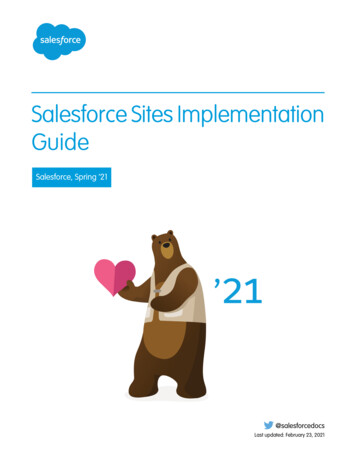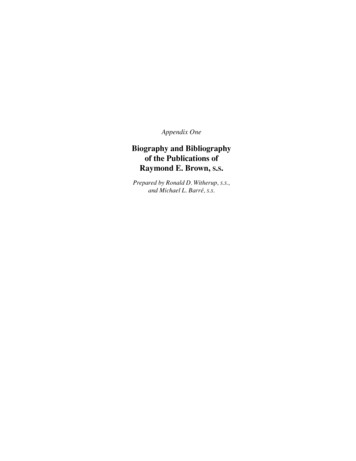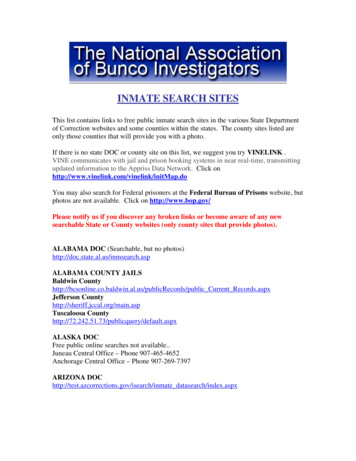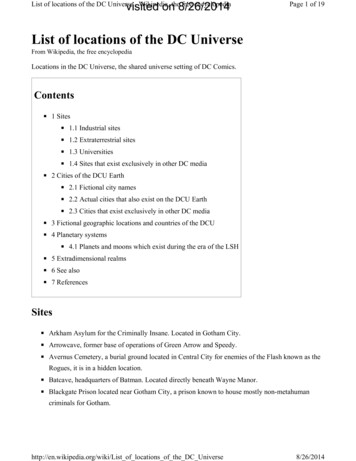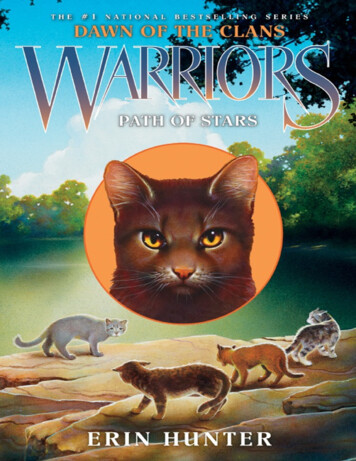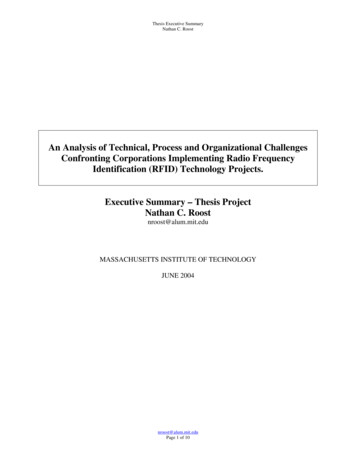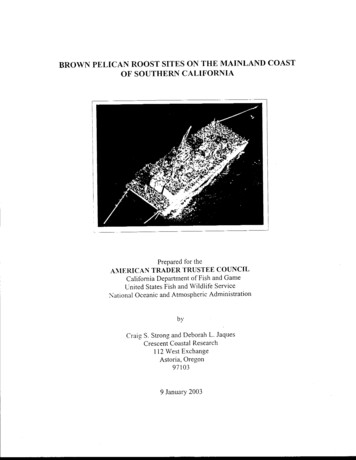
Transcription
BROWN PELICAN ROOST SITES ON THE MAINLAND COASTOF SOUTHERN CALIFORNIAPrepared for theAMERICAN TRADER TRUSTEE COUNCILCalifornia Department of Fish and GameUnited States Fish and Wildlife ServiceNational Oceanic and Atmospheric AdministrationbyCraig S. Strong and Deborah L. JaquesCrescent Coastal Research112 West ExchangeAstoria, Oregon9710310 January 2003
EXECUTIVE SUMMARYBrown Pelican (Pelecanus occidentalis californicus) distribution along the southern Californiamainland coast was analyzed using aerial survey data from 1986-2000 to provide managementinformation on use of communal roost habitat. Sixty traditional roosts were identified, of which4 were ranked as being of “major importance” (mean count 100 birds), and 25 as “important”sites (mean 30 birds). The breakwaters at Long Beach Harbor and Marina Del Rey providedthe highest quality habitat and supported the largest roosting aggregations. Most roost habitatconsisted of artificial structures, and most roosts were owned and managed by federal agencies.Roosts on private structures were subject to removal or alteration; two roosts on privatestructures were temporary and were eliminated during the study period, and others were injeopardy. Gaps in the availability of quality roost habitat occurred at the north end (SantaBarbara Co. and northern Ventura Co.) and south end (San Diego County) of the study area.Recommendations for restoration and improvement of roost habitat for Brown Pelicans includecreation of high quality roosts in south San Diego Bay, Batiquitos Lagoon, and the outer harborat Santa Barbara.ACKNOWLEDGMENTSThis analysis was supported by the American Trader Trustee Council (ATTC) and the NationalFish & Wildlife Foundation. We thank the American Trader Trustee Council and CaliforniaDept. of Fish and Game Office of Oil Spill Prevention and Response (OSPR) for supportingaerial surveys in 1998 and 1999. Aircraft and pilots were provided by CDFG Air Services inSacramento (Larry Heitz, director, and pilots Bob Morgan, Wayne Burnet, Bob Cole, RonVanBenthuysen, Kevin McBride, and Rich Anthes) and Ontario (Jeff Veal). Aerial photographicsurveys in 2000 were conducted by the U.S. Geologic Survey and Humboldt State University,with support from the U.S. Geologic Survey, U.S. Navy (Naval Air Station Point Mugu), andCDFG Office of Oil Spill Prevention and Response. We appreciate the efforts of Harry Carter(USGS Western Ecol. Res. Ctr, Dixon) and Paul Kelly (CDFG OSPR program) in developingthe data sharing agreement between this study and that of USGS/HSU.Field Observers who assisted with aerial surveys included Brad Keitt (Island Conservation &Ecology Group), Tom Keeney and Grace Smith (U.S. Navy, Point Mugu), Chris Depkin, andJohn Scholl. Thanks to ATTC members Carol Gorbics (USFWS Carlsbad Office), Paul Kelly(CDFG-OSPR), and Jennifer Boyce (NOAA Restoration Ctr.) for guidance and suggestions onthis project, and to Carol Gorbics for review and improvements to this report. Carol Gorbics andEmilie Luciani (USFWS) provided map graphics as well. Rebecca Kramer and Anna Weinstein(National Fish & Wildlife Foundation) provided contract and accounting support.i
TABLE OF CONTENTSEXECUTIVE SUMMARY . . . . . . . . . . . . . . . . . . . . . . . . . . . . . . . . . . . . . . . . . . . . . . . . . . . . iACKNOWLEDGMENTS. iCONTENTS . . . . . . . . . . . . . . . . . . . . . . . . . . . . . . . . . . . . . . . . . . . . . . . . . . . . . . . . . . . . . . . . iiINTRODUCTION . . . . . . . . . . . . . . . . . . . . . . . . . . . . . . . . . . . . . . . . . . . . . . . . . . . . . . . . . . . . . 1METHODS . . . . . . . . . . . . . . . . . . . . . . . . . . . . . . . . . . . . . . . . . . . . . . . . . . . . . . . . . . . . . . . . . . 2Data Collection . . . . . . . . . . . . . . . . . . . . . . . . . . . . . . . . . . . . . . . . . . . . . . . . . . . . . . . . . 2Analysis . . . . . . . . . . . . . . . . . . . . . . . . . . . . . . . . . . . . . . . . . . . . . . . . . . . . . . . . . . . . . . . 2RESULTS . . . . . . . . . . . . . . . . . . . . . . . . . . . . . . . . . . . . . . . . . . . . . . . . . . . . . . . . . . . . . . . . . . . 3Roost Habitat . . . . . . . . . . . . . . . . . . . . . . . . . . . . . . . . . . . . . . . . . . . . . . . . . . . . . . . . . . . 3Roost Ownership and Management . . . . . . . . . . . . . . . . . . . . . . . . . . . . . . . . . . . . . . . . . . 4Loss and Alteration of Roost Habitat . . . . . . . . . . . . . . . . . . . . . . . . . . . . . . . . . . . . . . . . 4Seasonal and inter-annual effects . . . . . . . . . . . . . . . . . . . . . . . . . . . . . . . . . . . . . . . . . . . 5Roost Habitat Distribution . . . . . . . . . . . . . . . . . . . . . . . . . . . . . . . . . . . . . . . . . . . . . . . . . 5State Wide Distribution . . . . . . . . . . . . . . . . . . . . . . . . . . . . . . . . . . . . . . . . . . . . . . . . . 5Roost Quality . . . . . . . . . . . . . . . . . . . . . . . . . . . . . . . . . . . . . . . . . . . . . . . . . . . . . . . . . . . 6Site Descriptions . . . . . . . . . . . . . . . . . . . . . . . . . . . . . . . . . . . . . . . . . . . . . . . . . . . . . . . . 7Tijuana River estuary, SD 1 . . . . . . . . . . . . . . . . . . . . . . . . . . . . . . . . . . . . . . . . . 7South San Diego Bay levees, SD 2.5 . . . . . . . . . . . . . . . . . . . . . . . . . . . . . . . . . . 7San Diego Bay, SD 2.8 . . . . . . . . . . . . . . . . . . . . . . . . . . . . . . . . . . . . . . . . . . . . . 7Zuniga Point, San Diego Bay mouth, SD 3.5 . . . . . . . . . . . . . . . . . . . . . . . . . . . . 8Naval Res. Electronics Lab. . . . . . . . . . . . . . . . . . . . . . . . . . . . . . . . . . . . . . . . . . 8Bird Rock, La Jolla . . . . . . . . . . . . . . . . . . . . . . . . . . . . . . . . . . . . . . . . . . . . . . . . 8La Jolla Caves area, SD 10 . . . . . . . . . . . . . . . . . . . . . . . . . . . . . . . . . . . . . . . . . . 9Batiquitos Lagoon, SD 11 . . . . . . . . . . . . . . . . . . . . . . . . . . . . . . . . . . . . . . . . . . . 9Agua Hedionda Lagoon, SD 12 . . . . . . . . . . . . . . . . . . . . . . . . . . . . . . . . . . . . . . 9Oceanside Harbor Jetty, SD 13 . . . . . . . . . . . . . . . . . . . . . . . . . . . . . . . . . . . . . . 10Dana Point Harbor jetties, OR 3 . . . . . . . . . . . . . . . . . . . . . . . . . . . . . . . . . . . . . 10Bolsa Chica Wetlands, OR 10.1 . . . . . . . . . . . . . . . . . . . . . . . . . . . . . . . . . . . . 10Anaheim Bay jetties OR 11 . . . . . . . . . . . . . . . . . . . . . . . . . . . . . . . . . . . . . . . . 10Long Beach Harbor breakwaters, LA 1 and 2 . . . . . . . . . . . . . . . . . . . . . . . . . . 10San Pedro Jetty, LA 3 . . . . . . . . . . . . . . . . . . . . . . . . . . . . . . . . . . . . . . . . . . . . . 11King Harbor jetties, LA 11 . . . . . . . . . . . . . . . . . . . . . . . . . . . . . . . . . . . . . . . . . 11Marina Del Rey breakwater . . . . . . . . . . . . . . . . . . . . . . . . . . . . . . . . . . . . . . . . . 11Malibu Lagoon, LA 16 . . . . . . . . . . . . . . . . . . . . . . . . . . . . . . . . . . . . . . . . . . . . 11Mugu Lagoon estuary, VN 4 . . . . . . . . . . . . . . . . . . . . . . . . . . . . . . . . . . . . . . . 12Santa Clara River estuary, VN 7 . . . . . . . . . . . . . . . . . . . . . . . . . . . . . . . . . . . . . 12Ventura Harbor, VN 6 . . . . . . . . . . . . . . . . . . . . . . . . . . . . . . . . . . . . . . . . . . . . . 12ii
CONTENTS, continuedMobil Oil pier and Rincon Island, VN 10 and 11 . . . . . . . . . . . . . . . . . . . . . . . . 13Outer Santa Barbara Harbor, SB 3 . . . . . . . . . . . . . . . . . . . . . . . . . . . . . . . . . . . 13Inner Santa Barbara Harbor, SB 4 . . . . . . . . . . . . . . . . . . . . . . . . . . . . . . . . . . . 13Coal Oil Point, Sandpiper Pier, SB 5 . . . . . . . . . . . . . . . . . . . . . . . . . . . . . . . . . 13Northern Santa Barbara County beaches, SB 8 and 9 . . . . . . . . . . . . . . . . . . . . 14CONCLUSIONS AND RECOMMENDATIONS . . . . . . . . . . . . . . . . . . . . . . . . . . . . . . . . . . . 14LITERATURE CITED . . . . . . . . . . . . . . . . . . . . . . . . . . . . . . . . . . . . . . . . . . . . . . . . . . . . . . . . 16LIST OF FIGURESFigure 1. The southern California coast, showing locations of Brown Pelican roosts . . . . . . . 18Figure 2. Brown Pelican roost habitat on the southern California mainland . . . . . . . . . . . . . . . 19Figure 3. Percent of Brown Pelican roost use by managing entity . . . . . . . . . . . . . . . . . . . . . . 20LIST OF TABLESTable 1. Summary of aerial survey effort on the southern California mainland coast . . . . . . . 21Table 2. Description of habitat type categories and codes used in text . . . . . . . . . . . . . . . . . . . 22Tables 3a- 3e. Diurnal Brown Pelican roost site summaries from fall air surveys . . . . . . . 23-27Table 4. Total counts of pelicans in 3 regions of the California coast, 1998-2000 . . . . . . . . . 28APPENDIX A. Site maps. . . . . . . . . . . . . . . . . . . . . . . . . . . . . . . . . . . . . . . . . . . . . . A1 - A11APPENDIX B. Air survey data, southern California 1998 and 1999 . . . . . . . . . . . . . . . B1 - B2iii
INTRODUCTIONThe California Brown Pelican (Pelecanus occidentalis californicus) is a common resident andmigrant of the southern California coastline and Channel Islands. The species is currently listedas federally Endangered, largely due to DDT and PCB pollution that caused widespreadreproductive failure during the 1960's and early 1970's (USFWS 1983). In the U.S., nesting onlyoccurs on Anacapa and Santa Barbara Islands in the Channel Islands National Park. Additionalnesting occurs on islands along the Pacific coast of Baja California and in the Gulf of California,Mexico (USFWS 1983). In 2001, the number of nest attempts and fledglings produced by thesouthern California nesting population was estimated at 3180 and 2550 individuals, respectively,though the number of nest attempts and fledglings produced is variable by year (range 1486 to5400 and 372 to 5530, respectively, during the past ten years (1992 to 2001, Gress 2002).Nesting takes place from February through June, and birds disperse throughout the Pacific coastbetween Mexico and British Columbia from about June through October (Anderson andAnderson 1976, Jaques 1994). Peak numbers occur along the southern California coastfollowing the nesting season, from June through October (Anderson and Anderson 1976, Briggset al. 1981, Jaques et al. 1996).Throughout their range, Brown Pelicans rely on a variety of shoreline structures as roost habitatto rest and restore their plumage. Roost habitat is essential habitat for pelicans, as their plumagebecomes soaked with prolonged water contact, and flying is energetically expensive (Rijke 1970,Pennycuik 1972, USFWS 1983). Roost sites are generally communal and traditional in that thebirds are found in groups rather than singly, and the same sites are used consistently over years.Overnight roost sites are restricted to the most secure roosts and have a strong traditionalcomponent, thus night roosts tend to be larger and fewer than diurnal ones. Throughout much oftheir non-breeding range, roosts are found on offshore rocks and islands where there isprotection from mammalian predators and human disturbance. On the southern California coast,natural roosting habitat for these birds is limited, and the majority of roosts are found onartificial structures (Jaques et al. 1996). Protection of roosting areas has become an increasinglyimportant management issue in California, as awareness of the potential adverse impact causedby human disturbance and habitat alteration has grown. For these reasons, the protection,creation and enhancement of roost habitat was selected as an effective means of restoringinjuries to Brown Pelicans caused by the American Trader oil spill of 1990 (American TraderTrustee Council 2001). The American Trader Restoration Plan details how creation,enhancement, and protection of Brown Pelican roost sites will benefit Brown Pelicans along thesouthern California coast.This report provides a summary of the current status of roost sites in southern California withinformation on recent changes (since 1986), and a comparison of pelican abundance in southernCalifornia relative to the rest of the state. The report is intended to provide information to aid inthe selection of restoration projects and as a baseline for quantifying the success of implementedrestoration projects. We include descriptions of all regularly used roost sites, assessments ofroost quality, and identification of regional gaps in suitable roost habitat.1
METHODSData CollectionIn 1986 and 1987 and again in 1992 and 1993, we conducted a series of air surveys of pelicansthroughout southern California. These data were reported in Jaques and Anderson (1987),Jaques (1994) and Jaques et al. (1996), and are summarized in this report. From 1998 to 2000additional fall air surveys were conducted. We carried out fall aerial surveys in 1998 and 1999as a part of the present study (source data in Appendix. B). Aerial photographic surveys in 2000were conducted by the U.S. Geologic Survey and Humboldt State University, with support fromthe U.S. Geologic Survey, U.S. Navy (Naval Air Station Point Mugu), and CDFG Office of OilSpill Prevention and Response. Aerial surveys were also completed for central and northernCalifornia in the 1998-2000 period using the same methods.Aerial survey flights were conducted in California DFG aircraft from 1986 to 1987 and 1998 to2000, and in Aspen Air Services aircraft in 1992 and 1993. Most surveys were conducted duringfall, when peak pelican populations in California usually occur, with additional surveysconducted in June and December. In total, 15 air surveys were conducted from the MexicanBorder to Point Conception, though fog and airspace restrictions limited the coverage on somesurveys (Table 1 and Figure 1). Point Conception itself was included in the central Californiatotal, as it was considered more representative of that region. Along with the pilot, two observerswere aboard during most surveys: the primary roost photographer and an overviewphotographer/data recorder who also tallied actively foraging pelicans on the seaward side of theplane.The survey plane flew at approximately 500 ft above sea level immediately offshore from theshoreline or roost habitat. All large roost sites were photographed with a 35 mm camera and200-300 mm lens out an open window at an oblique angle. Pelicans were later countedindividually from projected transparencies. Numbers of pelicans at small roosts (generally 20birds) and active birds (flying or feeding) within about 1 km of shore were tallied during theflight. Roost habitat was categorized into 11 habitat types based on physical habitatcharacteristics (Table 2).Ground surveys of selected roost sites were made in September 1999 and in July and Septemberof 2000 primarily for the purpose of studying night roost status and disturbance effects.Description of methods and results are contained in separate reports (Strong and Jaques 2002,Jaques and Strong 2002), but some counts based on ground surveys are mentioned here.AnalysisAll aerial roost counts from June through November were used for evaluating sites as roosts andcalculating mean use and frequency of use. December numbers were so low on the mainlandcoast that those data were not considered representative of roost site use. We considered alocation a roost site if three or more pelicans were present on more than one visit. Areas whereroosting birds were present with some consistency but at variable adjacent locations with similar2
habitat were combined into a single roost “site.” This occurred within harbors, along the rockyshores of Laguna Beach and Palos Verdes, and along the beaches of northern Ventura andnorthern Santa Barbara Counties. Habitat type of the roost site was also simplified to name themost commonly used or important roost substrate. For example, at Palos Verdes, where pelicansroosted both on the shore and on small offshore rocks, the habitat was categorized as “offshorerocks” (OSR) because it represented the more important roost substrate.RESULTSWe identified 60 Brown Pelican roost sites on the southern California mainland coast based onfall surveys in 1986-2000 (Tables 3a to 3e). Four roost sites that were identified in 1986 were nolonger available to pelicans in the 1998-2000 surveys (noted as “historic” in the tables). Twoadditional small roosts in Channel Islands and Ventura harbors were noted from the ground butnot in aerial surveys, and additional small roosts may have occurred within other harbors farthersouth. We considered a roost to be an important site if the mean number of birds present wasover 30 and frequency of occurrence was over 50%. A total of 25 roosts met these criteria(Figure 1). Only 4 sites were considered major roosts, with mean counts of over 100. Thelargest of these were the breakwaters of Long Beach Harbor and Marina Del Rey, followed byZuniga Point breakwater and Mugu lagoon estuary (Figure 1). Maps of roost locations are givenfor all important sites in Appendix B.The major roosts (mean counts 100 birds) described in this report are the same as found byJaques et al. (1996) using the 1992-93 data alone, with the exclusion of the Santa Barbara outerharbor and Mobil Oil Pier sites, now removed and unavailable to pelicans. Most important roostsites are also in common between the two studies, though the rank order varied between the twodata sets. Rank was assigned based on mean number of birds at the roost sites during oursurveys.Roost HabitatBreakwaters were by far the most important single habitat type, supporting 42.4% of all roostingpelicans, based on an average of all surveys of the southern California coast. Jetties were adistant second, with 13.5% of roosting birds, followed by other habitat types, each holding lessthan 10% of the total (Figure 2a). Artificial substrate comprised 22 of the 60 roosts, butsupported 66% of roosting pelicans. Offshore rocks were the most common roost type (andactually there are many more than the 13 indicated in Figure 2a, but these were grouped intosingle roosts if they were along similar coastline) but the rocks off southern California are smalland supported just 7% of the total.Artificial structures, Mugu Lagoon estuary and Malibu Lagoon estuary were used on more than60% of surveys (Figure 2b). The lower frequency of use of natural habitats is largely due totheir small size (offshore rocks) or higher incidence of disturbance (beaches, mainland shore,lagoon, and river mouths).3
Roost Ownership and ManagementThe Army Corps of Engineers is in charge of maintaining most breakwaters and jetties, 48.7% ofall pelicans, on average, roosted on habitat under their management (Figure 3). However,management of the structures usually involves a cooperative agreement between the U.S. ArmyCorps of Engineers and the respective local harbor district whose waters are protected by thejetty/breakwater structures.Other federal entities own or manage sites where 22.7% of the pelicans roosted (for a federaltotal of 71.4%). The BLM recently assumed management of all offshore rocks from CaliforniaDept. of Fish and Game, thus the state portion of roost management has been reduced. Anaverage 10.6% of all pelicans roosted on sites managed by the State of California. The mostimportant state managed roosts are those at Bolsa Chica Wetlands State Reserve (CDFG), SantaClara River mouth (McGrath State Park), Malibu Lagoon (Malibu Lagoon State Park), andBatiquitos Lagoon (CDFG). Just 11.5% of pelicans roosted on private structures in 1998-2000surveys, but this figure was 23.5% when historical data (1986-1993) are included.Loss and Alteration of Roost HabitatSince 1986, two major roost sites have been removed, two important roosts are under threat ofremoval or are being removed, one important site has been degraded, and two minor roosts havebeen lost to pelican use. No new roost sites have been created. All site losses have been onprivately owned property except one minor site (San Luis Rey river, SD 12.5).Private barges in the outer Santa Barbara Harbor and the Mobil Oil Pier, both in Santa BarbaraCounty, were among the largest roosts during the early 1990's. At that time, they ranked 3rd and4th in average use for the entire southern California coast. The barges used at Santa BarbaraHarbor were only available as roosts for a few years and were removed in fall 1992. The MobilOil Pier was removed under direction from State Lands Commission in 1996.The following describes additional current or possible future losses of individual roost sites: Efforts are being made to remove the roost at Agua Hedionda (SD 12) under the directionof the city of Carlsbad, because the city is concerned that water quality and ongoingmariculture operations may be adversely affected by the roost. This may have alreadybeen accomplished as we do not have data for the 2001 season. There is a directive from the State Lands Commission to remove the Arco oil platformnear Coal Oil Point, Santa Barbara County (Roost SB 5, ‘Sandpiper Pier’). The historic roost site at Batiquitos Lagoon was removed by CDFG in the mid 1990's.Currently the lagoon supports a minor roost on tidally exposed flats. A bait barge and other floating structures south of Malibu Lagoon were removed in 1993. A constructed island roost habitat at Luis Rey river mouth in Oceanside was eroded bywinter storms in 1992 and has not been replaced. Roost substrate within harbors can be variable on a scale of months to years as privatestructures are relocated or altered.4
Seasonal and inter-annual effectsThe number of pelicans using a given roost site along the southern California coast varies in asomewhat regular pattern by season, and is more variable inter-annually. Anderson andAnderson (1976), Briggs et al. (1981), and Jaques et al. (1996) describe a seasonal low inpelican numbers from December to May along the southern California coast, when most birdsare at nesting areas. Conversely, there is a higher abundance between June and October whenpelicans move from nesting areas to mainly coastal roost sites. The majority of birds passthrough southern California and on to central California, Oregon and Washington during theirannual post-breeding dispersal (Jaques 1994). Distribution and local areas of concentrationduring summer and fall varies between years. Peaks in abundance in southern California regionsoccur during a pulse of migration or when prey availability is high. During these times, largenumbers of pelicans can converge on an area making suitable local roost habitat a potentiallylimiting factor, and alternate or anomalous roost sites may be used during the day. An exampleof this occurred in June 1992 when over 500 pelicans were counted on Will Rogers State Beach(the beach was closed due to water pollution), and hundreds more were seen on nearby beachesin northern Los Angeles and southern Ventura Counties. Some of these sites never held over 3birds before or since and therefore did not qualify as traditional roosts in this analysis.During the El Nino event of 1992-93, few pelicans bred successfully in Mexico or on theChannel Islands (Gress et al. 1995), and numbers along the mainland shore of southernCalifornia were unusually high during both summer and winter (Figure 4). In other years, postbreeding birds may move rapidly through southern California to more northern points, resultingin very low fall survey totals. These effects cause high variability in roost counts, thus a seriesof surveys, such as presented in this report, are needed to provide representative information onroost site use.Roost Habitat DistributionGaps in roosting habitat along the coast can increase the energy requirements for pelicans as theymust access foraging areas over longer distances. Long stretches of shoreline lacking or withminimal roost habitat occur north and south from Santa Barbara Harbor (23.6 and 23.9 km,respectively), from Rincon Island to Ventura Harbor (19.3 km), between Mugu Lagoon andMalibu Lagoon (41.1 km), from Malibu Lagoon to Santa Monica ‘breakwater’ (17 km), andfrom Dana Point to Oceanside Harbor (38.1 km). Most gaps in diurnal roost habitat are in thenorthern half of the study area (Figure 1). The distribution of suitable night roosts is morelimited than that of diurnal roosts. A summary of night roost size and distribution is contained inStrong and Jaques 2002.State-wide DistributionSouthern California supported fewer pelicans than central or northern California on all recent fallsurveys (1998-2000) having just 10-11% of the total in each year (Table 4). Central Californiawas clearly the most important region, supporting 69 to 75 percent of the total in each year5
(Table 4). Central California had more roost sites and larger roosts (118 sites, average size of186 birds) compared with southern (60 sites, 51 birds on average) and northern (98 sites, 51birds on average) California. Great concentrations of pelicans in the Shell Beach area, atMonterey Bay roosts, at Ano Nuevo Island, and at estuaries and offshore rocks of Marin Countyduring the 1998-2000 period contributed to the large mean roost size in central CaliforniaRoost QualityQuality of a roost site can best be understood in terms of (a) capacity and (b) security fromdisturbance and adverse environmental conditions.Capacity: Maximum capacity can not be easily estimated other than by counts during episodesof high pelican abundance. At these times, behavioral observations show that birds are beingdisplaced by other birds or that birds are actively searching for suitable alternate roost locations.Pelicans were concentrated in central San Diego County during the 2000 air surveys, and theBird Rock roost (SD 9.0) was ‘overflowing’ in that pelicans were roosting on the adjacentmainland shore. From ground observations, roost sites at capacity occurred only on the artificialstructures in Agua Hedionda Lagoon on 07/11/00 and 09/13/00 and at Shell Beach rocks north ofPismo Beach in central California on 09/09-10/00. At both locations all available roosting siteswere occupied as dusk approached, and arriving birds were forced to land in water or continueflying. Birds were seen in the water the following dawn at both sites, and they quickly relocatedonto shore at first light. Capacity is expected to be limited at times on small rock roosts (such asat Laguna Beach), during tidal inundation (such as at Zuniga Point breakwater), and on smallerman-made structures such as at the Sandpiper Pier, Agua Hedionda, or on boats and barges inharbors. Breakwaters, jetties, and beach or rocky shorelines are often of potentially unlimitedcapacity, but quality can be affected by disturbance or environmental effects as described below.“Disturbance” is defined here as any event that causes pelicans to flush suddenly from theirroost. Disturbance from human sources (human presence, boats, dogs, autos, aircraft) andnatural sources (falcon, eagle, mammals) is the greatest identifiable source of observed roostquality degradation. Virtually all high quality roosts have a water buffer limiting or preventinghuman and mammalian access. On the southern California coast, roosts with a water buffer arelimited to breakwaters and the small rocks at Point Loma, Laguna Beach, and Palos Verdes.With the growing number and variety of watercraft, even these island habitats may be subject toincreasing levels of disturbance. A quantification and discussion of disturbance effects onsouthern California roost is contained in Jaques and Strong (2002).Environmental effects are those largely due to weather and sea conditions. Examples ofenvironmental effects on roost habitat quality are seen at the Ventura and Channel IslandsHarbor breakwaters, where large swells spray or wash over much of the breakwater, eliminatingroost habitat. Since large swells are most common in winter, this is typically a seasonal effect.Daily environmental effects are seen at Zuniga Point, where tidal inundation eliminates much ofthe roost at regular intervals. Winter storm flooding and shifting sand configurations alter roosthabitat at river mouths and estuaries on a scale from years to decades. The quality of roost6
habitat at Tijuana River, Malibu Lagoon, Mugu Lagoon, and Santa Clara River mouth is variabledue to changing configuration of sandbars and water buffers between people and roosting areas.Exposure to wind and rain is more acute at some roosts than others, such as exposed beaches andprobably on Sandpiper Pier (SB 5.0).Site DescriptionsBrief site descriptions follow for roosts categorized as ‘important’ (mean count 30) or thathave significance in terms of restoration potential, ordered south to north. Leading each accountis the site name and number (for cross-reference to Tables 3a to 3e and appendix B maps),ownership and management jurisdiction.Tijuana River estuary, SD 1 Map 1Owner/manager: U.S. Fish and Wildlife Service (USFWS), San Diego National Wildlife Refuge(NWR) and CDPR. CDPR property is on the south side of the river mouth, but most pelican useoccurs on the NWR. The capacity and quality of this roost is variable, depending on tidal stateand tidal and flood effects on sandbar configuration over the seasons. This area is also subject tofrequent disturbance from ground and helicopter traffic associated with immigrants trying to getinto the San Diego area and U.S. immigration officials patrolling for illegal border crossings. Itis unlikely that meaningful roost habitat improvements could be achieved here due todisturbance effects and varying natural conditions at the site.South San Diego Bay levees, SD 2.5 Map 1Owner/manager: Western Salt Company / USFWS San Diego NWR.Earthen levees us
We thank the American Trader Trustee Council and California Dept. of Fish and Game Office of Oil Spill Prevention and Response (OSPR) for supporting . We appreciate the efforts of Harry Carter (USGS Western Ecol. Res. Ctr, Dixon) and Paul Kelly (CDFG OSPR program) in developing . John Scholl. Thanks to ATTC members Carol Gorbics (USFWS .
